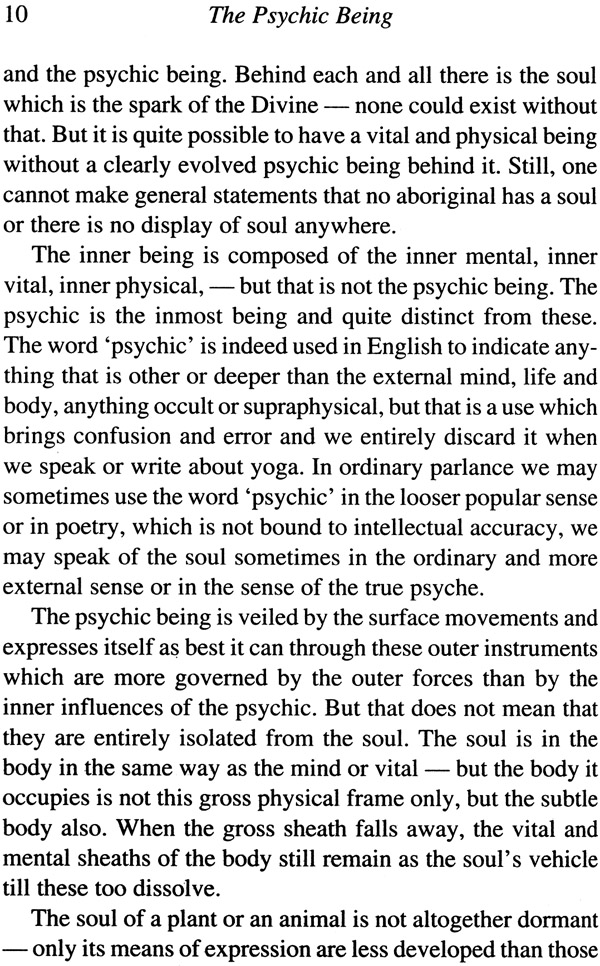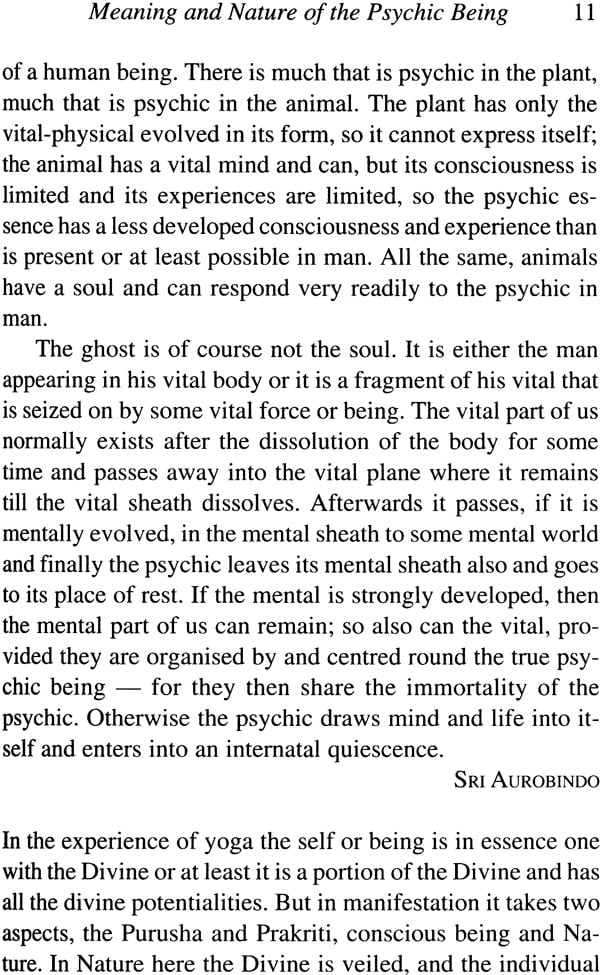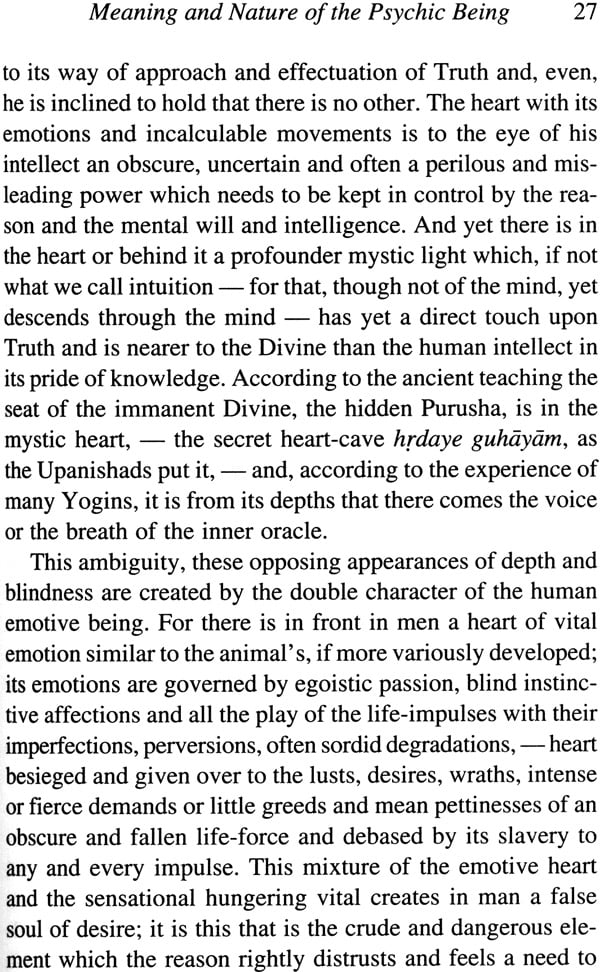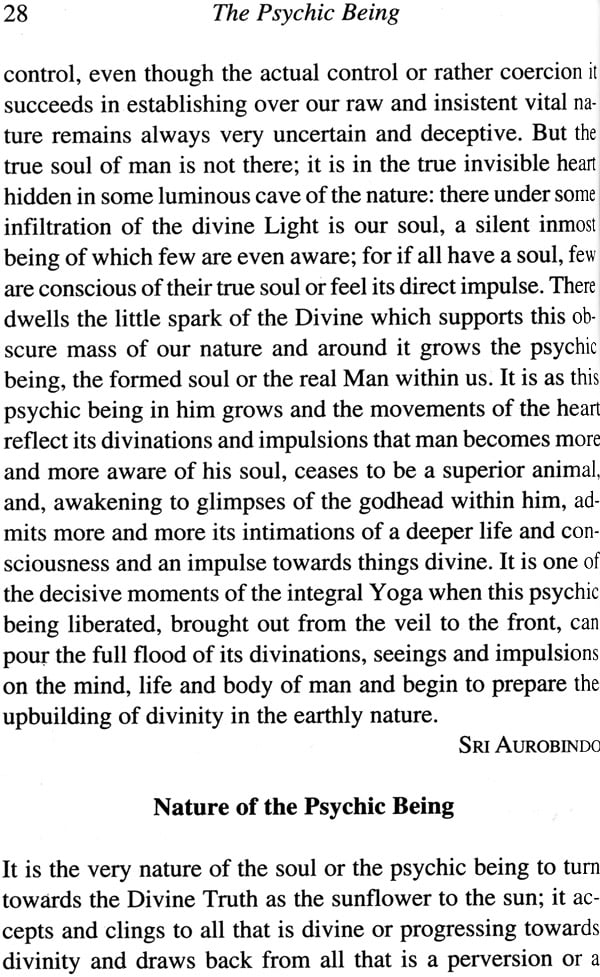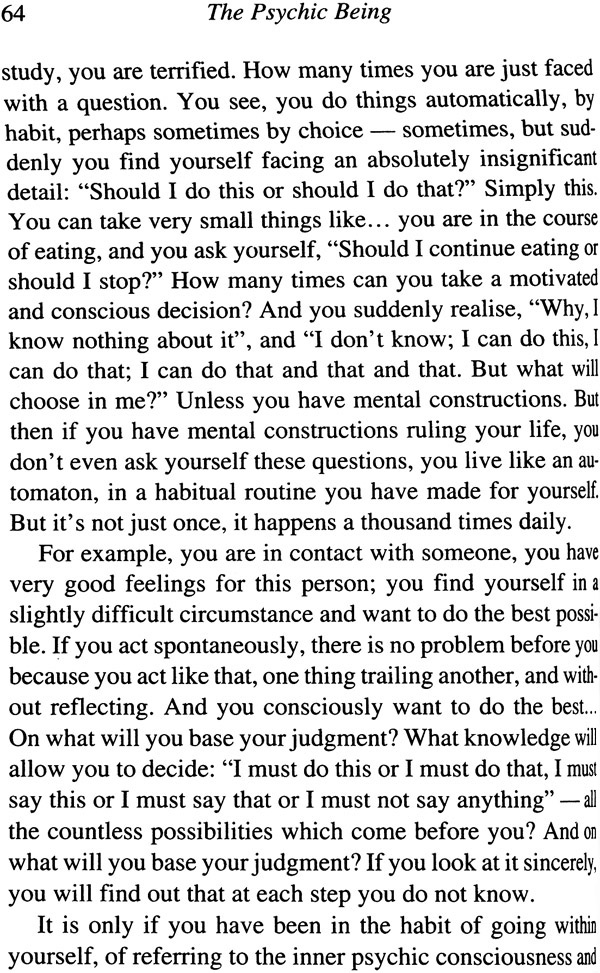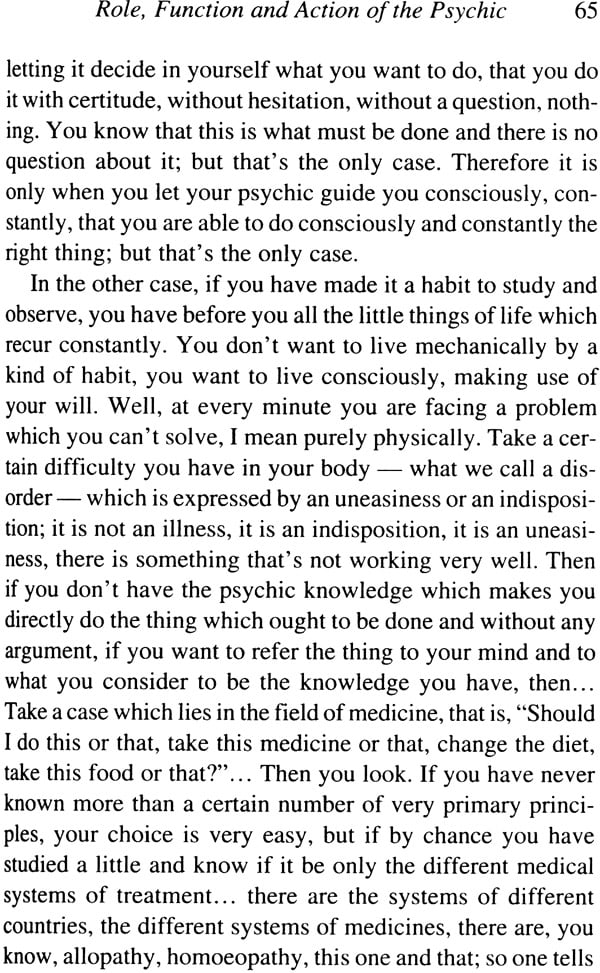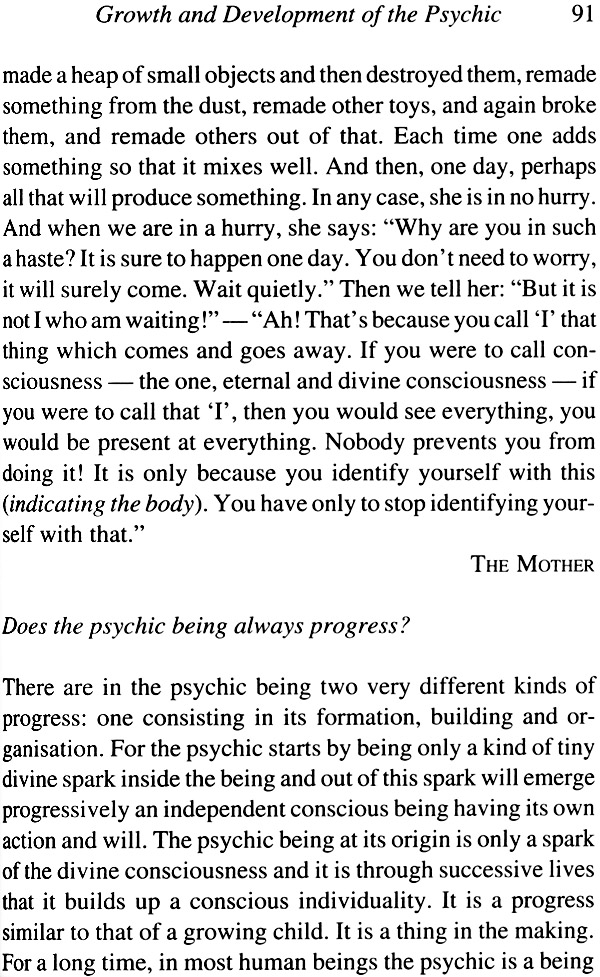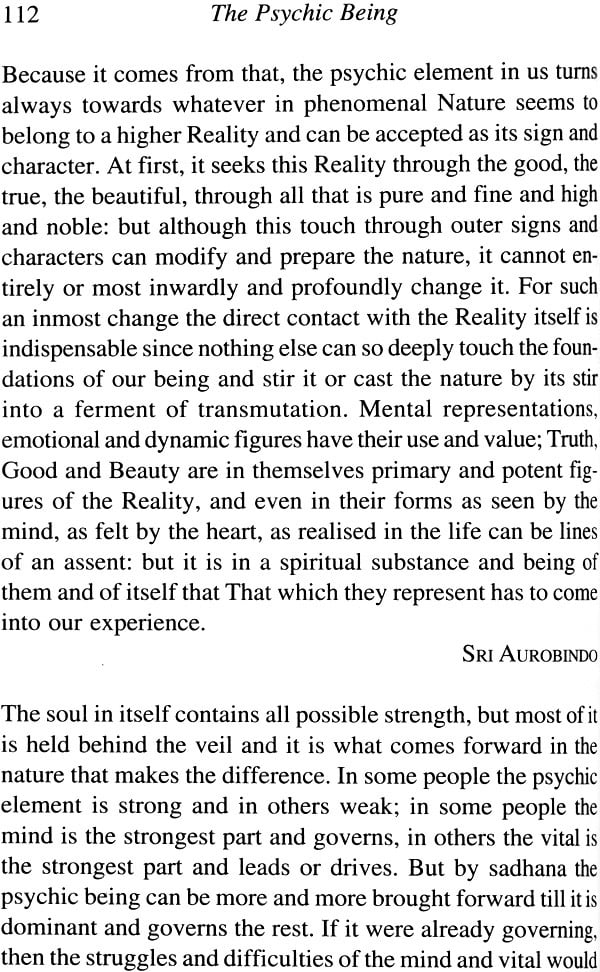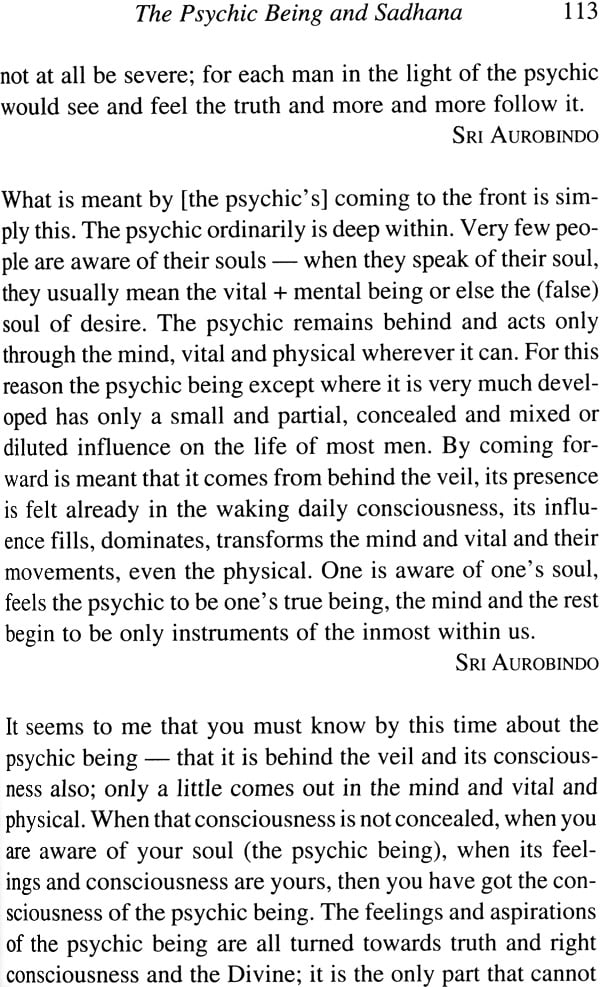
The Psychic Being (Soul: Its Nature, Mission and Evolution)
Book Specification
| Item Code: | NAK610 |
| Author: | A.S. Dalal |
| Publisher: | Sri Aurobindo Ashram, Pondicherry |
| Language: | English |
| Edition: | 2012 |
| ISBN: | 9788170588962 |
| Pages: | 240 |
| Cover: | Paperback |
| Other Details | 7.0 inch x 5.0 inch |
| Weight | 220 gm |
Book Description
About the Book
THE PSYCHIC BEING
Soul: Its Nature, Mission and Evolution
One of the special contributions to the lexicon of the Integral Yoga is Sri Aurobindo's introduction of the term psychic being. Standing immobile and silent behind the ordinary mental, vital and physical consciousness of man, the psychic being is the individual expression of the divine essence of each being. Through an accumulation of higher, Godward experiences during its terrestrial evolution, the psychic personality is developed, growing in strength and influence until it can "come entirely forward, breaking through the mental, vital and physical screen, govern the instincts and transform the nature".
As a true understanding of the concept of the psychic being is elemental to the practice of the Integral Yoga, this volume of extracts from the works of Sri Aurobindo and the Mother provides a direction for the spiritual seeker's first steps on the path of self- perfection. Written with clarity, precision, compassion and yogic insight, these selections define the nature of the psychic being; describe how to recognise its presence behind the stubborn assertiveness of the outer nature; and explain how the psychic power, when it comes forward to lead the sadhana, can open the rest of the nature to the supramental light and ananda.
Preface
The present compilation is an attempt to bring together in one volume the manifold teachings pertaining to the psychic being which are to be found in the numerous works of Sri Aurobindo and the Mother. The selections deal with the nature of the psychic being, shedding the light of Sri Aurobindo and the Mother on the inner constitution of the human being and on various related questions such as the process of inner growth, the after-life, rebirth, Sadhana or spiritual self-training, etc. Though the compilation is comprehensive, covering all the basic aspects of the subject-matter, it is not meant to be exhaustive. Being intended mainly for the general reader, it leaves out a good deal that would be of interest only to practitioners of Sri Aurobindo's yoga or to students of philosophy and philosophical psychology. The Selected Bibliography at the end of the book lists the major distinct sources where the interested reader will find additional material pertaining to the nature of the psychic being and its role in Sri Aurobindo's yoga.
In order to facilitate understanding, all the selections, except those in the last section of the book, have been classified into captioned sections and sub-sections, each dealing with a specific aspect of the subject-matter. However, since the book is a compilation from diverse sources, there is some overlapping as well as repetition in its contents. In order to maintain the wholeness and integrity of the extract, editing in the form of deleting statements within an extract or split- ting a passage into several parts to fit the classification has been avoided. For the same reason, parenthetical remarks and statements pertaining to a topic other than the main theme of an extract, often found in Sri Aurobindo's letters and the Mother's answers to questions, have generally been retained.
The reason why Sri Aurobindo adopted the term "psychic being" has been stated by him as follows:
"The word soul is very vaguely used in English - as it often refers to the whole non-physical consciousness including even the vital with all its desires and passions. That is why the word psychic being has to be used so as to distinguish this divine portion from the instrumental parts of the nature."
The word "psychic" too, as Sri Aurobindo points out, has been used in a confused manner. Therefore the first section of the compilation contains extracts which deal with the various meanings of the words "soul" and "psychic", and clarify their connotations in Sri Aurobindo's yoga. To avoid confusion to those who might read some of Sri Aurobindo's earlier writings, particularly the unrevised parts of The Synthesis of Yoga, it may be pointed out that Sri Aurobindo had at first used the terms "psychic" and "psychical" interchangeably in referring to the occult phenomena. He also used the term "psychic" in such expressions as "psychic Prana" (as distinguished from physical Prana) and "psychic soul" (as distinguished from the desire-soul) to distinguish what is deeper or below the surface from that which is more on the surface. However, in the revised parts of the earlier writings and in later writings, he always used the term "psychic" to refer to the soul or inmost part of the being, which from the very beginning he called the psyche.
One of the most important points to be grasped clearly is the vital distinction between the soul in its essence - referred to variously by Sri Aurobindo as the psyche, psychic essence, psychic entity, psychic existence, soul-spark or soul element - and the soul in its evolved, individualised form, called the psychic being, psychic personality, soul-form, or soul-personality, which, in Sri Aurobindo's words, is "the spark growing into a fire, evolving with the growth of consciousness". * It should also be pointed out that the terms "soul" and "the psychic", when used without an epithet, some- times refer to the soul-spark or psychic essence and some- times to the soul-personality or psychic being.
The nature and function of the psychic being cannot be well explained without reference to other parts of the being. Therefore, the reader will find in this compilation frequent mention of the different parts of the being, several of which are designated by special terms in Sri Aurobindo's yoga. The Glossary at the end of the book includes these key terms in addition to Sanskrit terms as well as common English terms used in a special sense in Integral Yoga. It should be noted that some of the Sanskrit terms have a wider connotation than what is stated in the Glossary, and may have a different meaning in other contexts.
Contents
| Preface | I |
| SECTION I |
|
| Meaning and Nature of the Psychic Being | 3 |
| What is Meant by the Psychic Being | 13 |
| Atman, Jivatman and the Psychic Psychic-Mental, Psychic-Vital, Psychic-Physical | 21 |
| The Double Soul | 24 |
| Nature of the Psychic Being | 28 |
| The Psychic and the Spiritual | 36 |
| Emotion and Love - Vital and Psychic | 39 |
| Knowledge - Mental and Psychic | 43 |
| SECTION II |
|
| Role, Function and Action of the Psychic |
|
| Function of the Psychic | 49 |
| Influence and Action of the Psychic | 52 |
| Guidance through Organisation of Life | 60 |
| The Psychic Being - Centre for Self- Unification | 67 |
| SECTION III |
|
| Growth and Development of the Psychic |
|
| Evolution and the Psychic | 75 |
| Process of Psychic Growth and Development | 81 |
| SECTION IV |
|
| The Psychic Being and Sadhana |
|
| Three Steps of Self-Realisation and Triple Transformation | 103 |
| Becoming Conscious of the Psychic Being Need for Sadhana | 105 |
| The Psychic Being and Conversion | 107 |
| Psychic Change-First Necessity | 109 |
| Emergence of the Psychic-Bringing Forward the Psychic | 111 |
| The Sunlit Way of the Psychic | 122 |
| SECTION V |
|
| The Afterlife and Rebirth |
|
| The Process of Rebirth | 129 |
| What Survives after Death and Reincarnates | 134 |
| The Psychic’s Choice and Conditions of Rebirth | 137 |
| Memory of Past Lives | 151 |
| SECTION VI |
|
| More Lights on the Psychic Being | 161 |
| Glossary | 201 |
| References | 214 |
| Selected Bibliography | 217 |
| Index | 218 |
